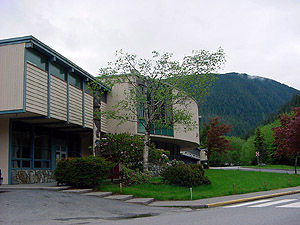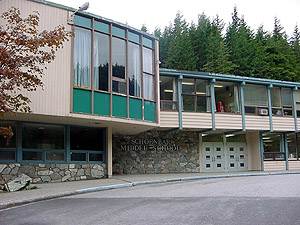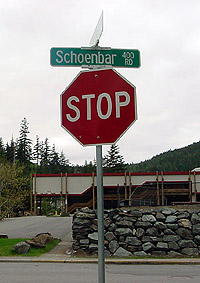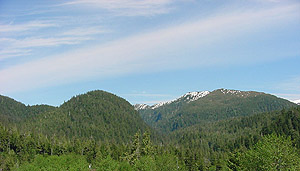 By June Allen June 09, 2002
By 1964, when a name for the new junior high was being selected, there was some sentiment that O.M. Lien Junior High would be appropriate, named for another dedicated and longtime school board member. There were others, however, who thought it might not be a good idea to set a long-term precedent of naming schools after people. So the school was named Schoenbar, for the road on which it is located. Interesting. The school was named for the road which was named for the early-century tramline/trail that led from Harris Street to the Laskawanna gold mine, which was renamed Schoenbar mine, which was named for Col. John Schoenbar - who was never a colonel and whose name was more accurately spelled Shoenbar - minus the c. And sometimes Shonebar. If anyone in Ketchikan remembered who John Schoenbar was in 1964-65 when the school was named, they didn't mention it. Maybe it was best that the town didn't remember in 1965. Col. Schoenbar was a true Gold Rush character who was either a victim of hard luck or one of the era's many skilled con
Little was known about him almost a century later except for a few mentions of him in the early century Mining Journal and a social mention or two some years later when he visited the city. Then in 1997 a man living near Sullivan, Maine, ran across a mention of Ketchikan's Schoenbar School and contacted the city's museum to ask for information about its namesake. I was given the man's name and we exchanged letters and information. Bob Potter and his wife had retired to Maine after his 40 years as a chemist in Connecticut. Looking for a hobby or pastime, Potter joined the town's historical society and chose one John Shoenbar, a miner and entrepreneur of the 1870s in Sullivan, Maine, as someone to research. In Potters own words - "Now I'm obsessed by the man!" That's not surprising. Potter's collection of documentation showed Shoenbar lived a rather adventurous life and played fast and loose with the truth in legal documents that survive. He affirmed on various documents that he was born either in 1831 (likely) or 1841 or 1845, take your pick. He also affirmed that he was born in Russia, but in the 1900 census collected in Ketchikan, he said that he was born in New York and thereby was a citizen. His parents were born in Russia on some documents and in Germany on others. (When he lived in Boston he lived in a German-speaking neighborhood.) His wife's name was Mamie, or maybe Marie - somewhere in the neighborhood of ten years his junior, and she was born in Ohio. He listed San Francisco as his home address, and that may have been true. John Schoenbar apparently cherished his wife, his self-acclaimed reputation as a mining engineer, and his dreams of mining success and land acquisition. Unfortunately for him, every time he did manage to climb the ladder of success, Lady Luck deserted him.
A decade later the couple showed up in Sullivan, Maine, to repeat their investment and property strategies in that silver boomtown. He tried the mining scene but the boom faded too quickly. So next Schoenbar claimed to be an editor himself and also bought a resort hotel, which he promoted heavily by booking "religious services and sacred concerts" in its spacious public rooms. He later made an offer to the Maine Legislature to ask the lawmakers to allow him start a bottled water company. But it didn't happen. His earlier pattern of failure followed him and by the mid-1890s he had disappeared, to reappear in 1899 in Ketchikan, where he had promoted himself from lieutenant to colonel! In 1900 Ketchikan, Col. Schoenbar acquired the Laskawana mine and its water rights in Bear Valley and renamed it the Schoenbar mine. The mine contained low-grade copper, gold and silver. The next mention of him is in 1902 when a newspaper item said Schoenbar's rights to his water claim were settled by the "couple of men working the mine" and by the operation of a stamp mill. Mining historian John Bufvers stated in later years that there was no mill at the mine, in spite of the newspaper story. But there had been work done, including a tunnel said to have been some 80 feet long. This was the tunnel that would be used to an air raid shelter during World War II. In 1903 Col. Schoenbar borrowed money from Heckman, and maybe others. Then he again made the news in May 1904 when the city council allowed him to build a tramway through
Schoenbar was so respected in the business community that in 1906 - when lack of funding stopped the Schoenbar mine's work - the Ketchikan Commercial Club, the forerunner of today's Chamber of Commerce, raised the money to send the mining engineer to Boston and New York to interest influential men in investing in mining properties in the Ketchikan mining district. While in the East, the Colonel conveniently "established residency" in both Boston and New York. He returned to Ketchikan but he and Mamie/Marie left shortly after. Because of a national recession, the bottom fell out of the metals market in 1907 and almost all regional mine work was ended His office on Park Avenue stood vacant and in 1913 his mine warehouse was used as an isolation hospital, called a "pest (pestilence) house" in those days, during an outbreak of disease, possibly smallpox. A later newspaper notice mentioned that Schoenbar did visit Ketchikan again, just after World War I. He and his wife both died in Oakland. The entire Schoenbar mine operation would sit idle for a quarter century. Then in 1933, in the depths of the Great Depression, one Charles L. Smith, mining engineer, arrived in Ketchikan. He charmed one and all with his vast knowledge of mining, amazing people by mentioning the textbook name of every rock he saw. He said the Schoenbar mine could be reactivated, he said, not by more tunneling, but by separating the gold and silver from the surface ore - by a cyanide process. Once again the town rallied. Smith had free rent, credit for anything else, and worked his con man magic. The only problem was that the cyanide solution (which later mine historian Bufvers said wasn't strong enough to kill a fly) didn't do the job. But Smith got his year's worth of free room and board, which was probably what he wanted anyway in those hard times. So the name Schoenbar today? Perhaps it relates to community spirit, a willingness to help one another in hard times and at least try to make a go of a new, or renewed, business venture. What's in a name anyway...
Photos by Dick Kauffman
|
|||||



